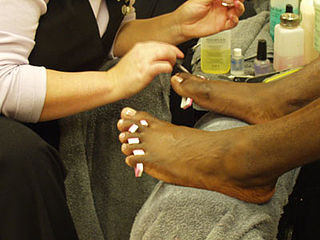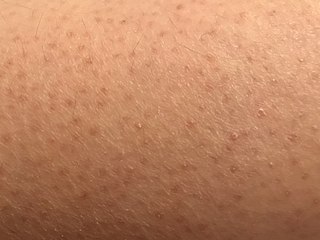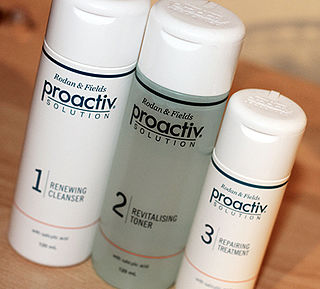
Acne, also known as acne vulgaris, is a long-term skin condition that occurs when dead skin cells and oil from the skin clog hair follicles. Typical features of the condition include blackheads or whiteheads, pimples, oily skin, and possible scarring. It primarily affects skin with a relatively high number of oil glands, including the face, upper part of the chest, and back. The resulting appearance can lead to lack of confidence, anxiety, reduced self-esteem, and, in extreme cases, depression or thoughts of suicide.

Cosmetics are composed of mixtures of chemical compounds derived from either natural sources or synthetically created ones. Cosmetics have various purposes. Those designed for personal care and skin care can be used to cleanse or protect the body and skin. Cosmetics designed to enhance or alter one's appearance (makeup) can be used to conceal blemishes, enhance one's natural features, add color to a person's face, or change the appearance of the face entirely to resemble a different person, creature or object. Cosmetics can also be designed to add fragrance to the body.

A pedicure is a cosmetic treatment of the feet and toenails, analogous to a manicure.

Tretinoin, also known as all-trans retinoic acid (ATRA), is a medication used for the treatment of acne and acute promyelocytic leukemia. For acne, it is applied to the skin as a cream, gel or ointment. For leukemia, it is taken by mouth for up to three months. Topical tretinoin is also the most extensively investigated retinoid therapy for photoaging.

Rosacea is a long-term skin condition that typically affects the face. It results in redness, pimples, swelling, and small and superficial dilated blood vessels. Often, the nose, cheeks, forehead, and chin are most involved. A red, enlarged nose may occur in severe disease, a condition known as rhinophyma.
Banish is an American brand of skincare products founded by Daisy Jing in 2013. The line of products includes oils, microneedling kits, vitamin C serums, exfoliating masks and other treatments for acne scarring.

Keratosis pilaris is a common, autosomal-dominant, genetic condition of the skin's hair follicles characterized by the appearance of possibly itchy, small, gooseflesh-like bumps, with varying degrees of reddening or inflammation. It most often appears on the outer sides of the upper arms, thighs, face, back, and buttocks; KP can also occur on the hands, and tops of legs, sides, or any body part except glabrous (hairless) skin. Often the lesions can appear on the face, which may be mistaken for acne or folliculitis.
The term cleanser refers to a product that cleans or removes dirt or other substances. A cleanser could be a detergent, and there are many types of cleansers that are produced with a specific objective or focus. For instance, a degreaser or carburetor cleanser used in automotive mechanics for cleaning certain engine and car parts.
Dermabrasion is a type of surgical skin planing, generally with the goal of removing acne, scarring and other skin or tissue irregularities, typically performed in a professional medical setting by a dermatologist or plastic surgeon trained specifically in this procedure. Dermabrasion has been practiced for many years and involves the controlled deeper abrasion of the upper to mid layers of the skin with any variety of strong abrasive devices including a wire brush, diamond wheel or fraise, sterilized sandpaper, salt crystals or other mechanical means.

A concealer or color corrector is a type of cosmetic that is used to mask imperfections on the skin. These imperfections can include dark circles under the eyes, blemishes, and hyperpigmentation. Concealer is similar to, and can be used in conjunction with foundation, a lighter cosmetic that is used to even out the skin tone. Both concealer and foundation are typically used to make skin appear more uniform in color. These two types of cosmetics differ in that concealers tend to be more heavily pigmented, though concealer and foundation are both available in a wide range of colors and opacities.

Proactiv is an American brand of skin-care products developed by two American dermatologists, Katie Rodan and Kathy A. Fields, and launched in 1995 by Guthy-Renker, a California-based direct marketing company, that was endorsed by famous celebrities The range includes moisturizers, body washes and treatment products, but the brand is known for its three-step anti-acne Solutions 3-step routine consisting of a BPO cleanser, glycolic toner and treatment lotion. Proactiv+, a reformulation of the three-step kit, was introduced in 2013, and in 2017, ProactivMD launches powered by Adapalene.

In cosmetics, skin toner or simply toner refers to a lotion, tonic or wash designed to cleanse the skin and shrink the appearance of pores, usually used on the face. It also moisturizes, protects and refreshes the skin. Toners can be applied to the skin in different ways:

In cosmetology, exfoliation is the removal of the surface skin cells and built-up dirt from the skin's surface. The term comes from the Latin word exfoliare. This is a regular practice within the cosmetic industry, both for its outcome of promoting skin regeneration as well as providing a deep cleanse of the skin barrier. Being used in facials, this process can be achieved by mechanical or chemical means, such as microdermabrasion or chemical peels. Exfoliants are advertised as treatments that enhance beauty and promote a youthful and healthy appearance.

Skin care or skincare is a range of practices that support skin integrity, enhance its appearance, and relieve skin conditions. They can include nutrition, avoidance of excessive sun exposure, and appropriate use of emollients. Practices that enhance appearance include the use of cosmetics, botulinum, exfoliation, fillers, laser resurfacing, microdermabrasion, peels, retinol therapy, and ultrasonic skin treatment. Skin care is a routine daily procedure in many settings, such as skin that is either too dry or too moist, and prevention of dermatitis and prevention of skin injuries.
A chemical peel is a treatment used to improve and smooth the texture of the skin. The skin on the face is most commonly treated, but peels can also be performed on the body. Chemical peels are intended to remove the outermost layers of the skin. To accomplish this task, the chosen peel solution induces a controlled injury to the skin, which causes the skin to peel. This process leads to smoother skin can improve fine lines, acne scars, and pigment. Medium depth peels must be performed by a medical provider.

A facial mask is a creamy or thick pasted mask applied to the face for cleansing or skin-smoothing purposes. Facial masks often contain minerals, vitamins, and fruit extracts, such as cactus and cucumber. A sheet mask is a piece of paper, cellulose or fabric used to apply a facial mask.
Personal care products are consumer products which are applied on various external parts of the body such as skin, hair, nails, lips, external genital and anal areas, as well as teeth and mucous membrane of the oral cavity, in order to make them clean, protect them from harmful germs and keep them in good condition. They promote personal hygiene and overall health, well-being and appearance of those body parts. Toiletries form a narrower category of personal care products which are used for basic hygiene and cleanliness as a part of a daily routine. Cosmetic products, in contrast, are used for personal grooming and beautification. Pharmaceutical products are not considered personal care products.
Acne mechanica is an acneiform eruption that has been observed after repetitive physical trauma to the skin such as rubbing, occurring from clothing or sports equipment. In addition to those mechanisms, the skin not getting enough exposure to air also contributes to the formation of acne mechanica. It is often mistaken as a rash that forms on sweaty skin that is constantly being rubbed, but in reality, it is a breakout of acne mechanica. The term "acne" itself describes the occurrence in which hair follicles in the skin get clogged by oil, dead skin cells, dirt and bacteria, or cosmetic products and create a pimple. Pimples can vary in type, size, and shape, but the sole basis of them occurring is the same - the oil gland in the pore becomes clogged and sometimes infected, which creates pus in order to fight the infection and subsequently causes the development of swollen, red lesions on the skin.

A pimple or zit is a kind of comedo that results from excess sebum and dead skin cells getting trapped in the pores of the skin. In its aggravated state, it may evolve into a pustule or papule. Pimples can be treated by acne medications, antibiotics, and anti-inflammatories prescribed by a physician, or various over the counter remedies purchased at a pharmacy.
A cosmetic primer is a cream applied before another cosmetic to improve coverage and lengthen the amount of time the cosmetic lasts on the face.













